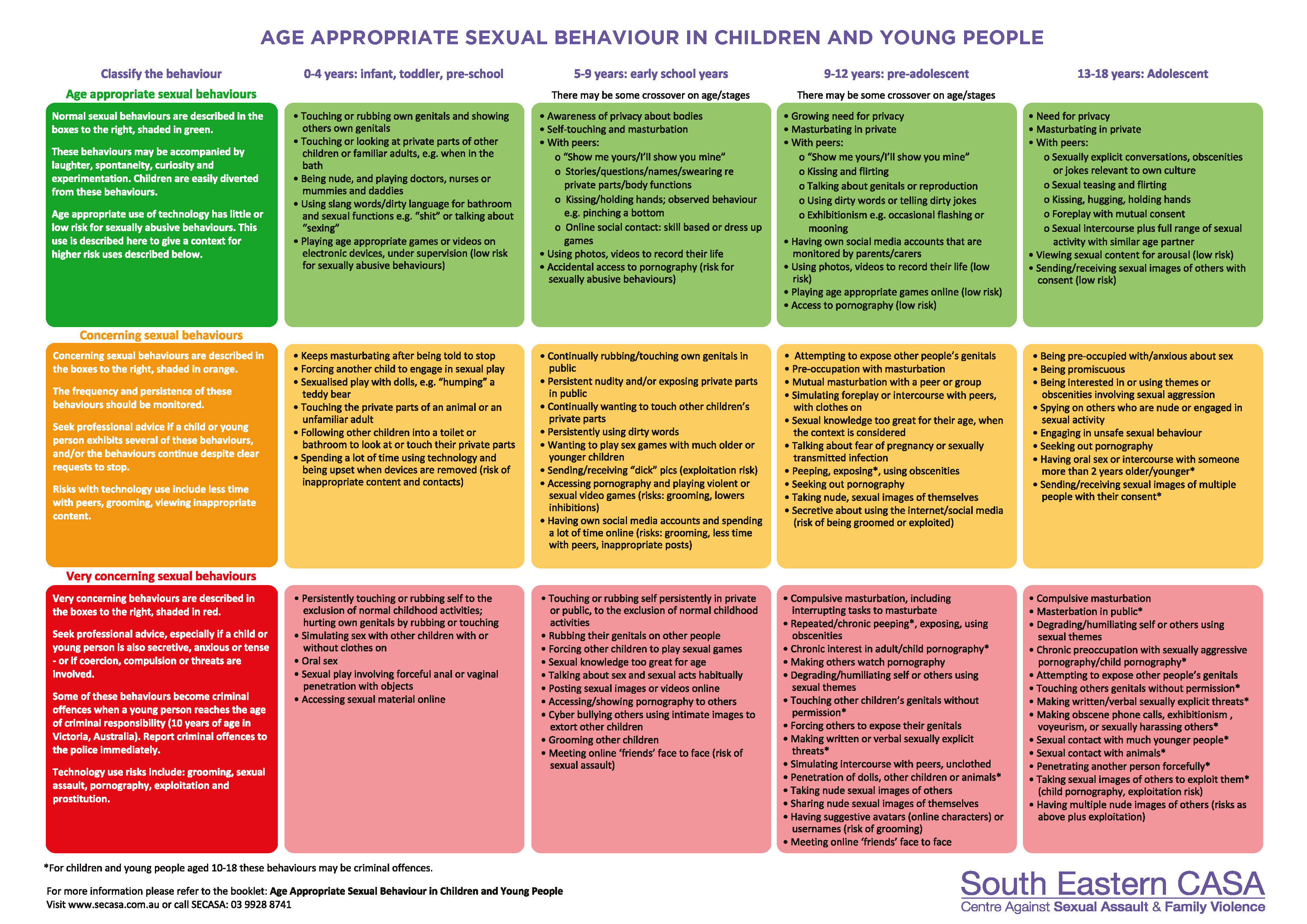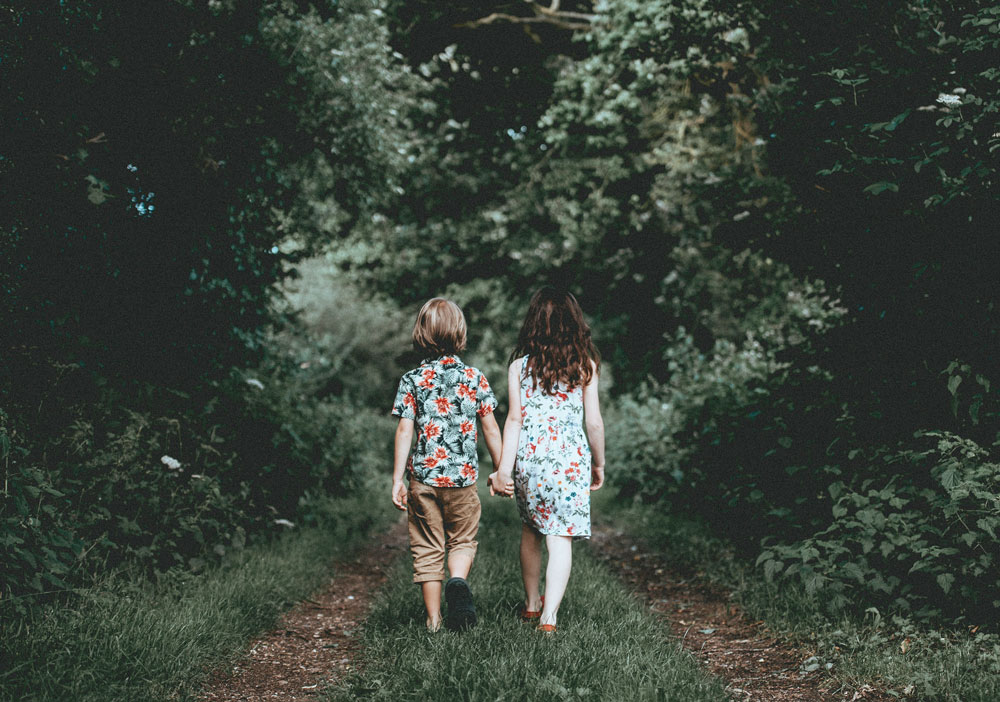This information is very important for carers, professionals and the general public. We need to be able to determine and understand what is normative (age-appropriate) sexual behaviour in children, and sexual behaviours in that are concerning, and very concerning (abusive).
We need to know when we should be concerned about a child or young person’s sexual behaviour and when we need to get a professional involved. The problem is not that young people use technology. It is appropriate for them to develop technology skills and knowledge that they will need throughout their life. Problems arise when young people use technology to engage in sexually problematic or abusive behaviours, which at times may be seen as bullying or blackmailing others, transmitting images or videos that are illegal under current legislation or come into contact online with people who seek to exploit them.
We know that if concerning sexual behaviours are not responded to early, problems may emerge in children and young people’s sexual development. Some children and young people are more at risk of developing concerning sexual behaviours.
There are many influences on children and young people’s sexual behaviour. Most problem sexual behaviours are not due to a background history of sexual abuse. Age-appropriate sexual behaviours can become disrupted in children and young people for several reasons.
These include but are not limited to: Accidental/non-accidental exposure to sexually explicit material such as internet pornography, or other forms of pornography; Exposure to adult sexual activity; Physical abuse and emotional neglect (cumulative harm); Being exposed to family violence; Re-enacting one’s own childhood abuse and loss of significant others.
When we evaluate children and young people’s sexual behaviours, it is important that we consider and understand our own values about sexuality and sexual practices. There have been many changes over the past 30 years in mainstream Western attitudes about sex. Because of this some children and young people are increasingly exposed to sexual themes in their homes, amongst their peers, whilst online and via other media exposure.
Child development incorporates physical, emotional, cognitive and sexual development. Children and young people develop sexually, just as they do emotionally, mentally, cognitively and physically. The range of normative, age-appropriate sexual behaviour changes as a child or young person grows and develops. Most sexual behaviour displayed by children and young people will “sit within” a normative development range. The challenge for carers and professionals is to identify sexual behaviours that fall outside this range and then assist the young person to seek help for those problematic behaviours.
The internet has become a source of increasing concern for parents and professionals, given the availability of sexually explicit materials and the presence of online predators. There are also concerns around children being groomed online and young people using technology to record others and then sharing inappropriate images. Young people should be educated and assisted to understand how online sexual content and activity fits in with relationships, romance and sex, and that some restrictions and supervision are necessary for their own protection.
Professionals, who identify children exhibiting problematic and sexually abusive behaviours that may be driven by exposure to pornography, should:
• Ensure they have a good understanding of child development principles, including ages and stages
• Understand cyber-safety strategies and e-safety principles relevant for those ages and stages, and be competent and comfortable in talking with children and young people about these issues
• Be able to refer a child to other professionals who are skilled in this area, if they are not comfortable talking about these issues themselves.
It is important to respond quickly to sexually problematic or abusive behaviours. Current research informs us that very few children and young people will go on to become adult sexual offenders. Children and young people respond well to treatment. However, for a very small number of children and young people these emerging patterns may continue into adulthood.
There are 3 ranges, or classifications, of sexual behaviour: age-appropriate (normative), concerning and very concerning. We have broken down these ranges of sexual behaviours into four (4) age and developmental stage groupings: 0 – 4 years; 5 – 9 years; 9 – 12 years and 13 – 18 years.
Children or young people who are intellectually disabled or developmentally delayed experience normal physical sexual development. These children and young people are over-represented in the population of young people displaying problem or sexually abusive behaviours. Their behaviour should not be ignored because of the disability or developmental delay, and chronological rather than emotional age should be used when making decisions about appropriate behaviour. Intellectual disability makes these children and young people more vulnerable to exploitation. Their problematic and sexually abusive behaviour can also have an adverse impact on themselves and other children and young people around them.
Cognitive impairment issues and the growing cohort of children and young people who present with Autism Spectrum Disorder (ASD), Attention Deficit Disorder (ADD) and Attention Deficit Hyperactivity Disorder (ADHD) driven behaviours, present particular issues for those who work in this field. The impact of these issues can mean that children and young people struggle to understand the social rules around sexual practices and relationships. Fixations may also emerge, particularly around online sexually explicit materials, and may develop quickly if not detected and managed early.
Do not underestimate the appeal of sexually explicit materials to a young person on the autism spectrum, especially when this is paired with masturbation and other sexual stimulation.
How to respond
How you react when you notice sexual behaviour in children and young people is very important. It ‘sets the tone’ for your ongoing relationship and potential for successful treatment. Your response to children and young people’s sexual behaviours is very important. Individual values and attitudes about sexual behaviours may lead to minimising or over-reacting to the behaviours. The initial response by people around the child or young person can significantly impact the child or young person’s feelings of embarrassment or shame, and their ability or willingness to then address the behaviour.
What to do
When you observe or find out about sexual behaviours in children and young people:
• Keep calm. Children and young people often do not understand that the behaviour is wrong, or why they behave this way. Your response is important in ensuring the child is able to manage any confusion, anxiety, shame or anger about their behaviour
If you discover the child engaged in the behaviour, clearly and calmly ask them to stop, and distract them with a different activity, talk with them about the behaviour and discuss privacy and personal boundaries, ensure you do not make them feel embarrassed or ashamed and discretely, keep a record of the behaviour, including: The behaviours exhibited, the context, date, time, frequency
Remember; never use the record of the behaviour as a way of punishing the child or young person.
What not to do
• Appear shocked
• React in a way that makes the child or young person feel embarrassed or ashamed
• Ignore the behaviour
• Assume that sexual abuse has happened
• Use language that labels a child or young person a “pervert” or “sex offender”.
Referring a child or young person for further professional help
If you have considered the behaviour and the context in which it happened, and decided that the behaviour is concerning or very concerning:
• Carers or professionals working with children and young people – talk to your caseworker, manager or supervisor to determine whether a referral should be made. See “Seek further advice or make a referral” section for more information.
• Parents – contact one of the agencies listed in the “Seek further advice or make a referral” section for information and help options.
What happens when a referral is made?
The agency counsellor or clinician will assess the situation to ensure that your child is safe. Your child will be assessed to determine the options and best way to proceed. As their parent/carer, you are likely to be included in the assessment process.
The goal of the assessment is to identify as many aspects of the situation related to the behaviour as possible, focussing on questions that include: Who, What, When, Where and Why?
The assessment enables the counsellor or clinician to make a report on the child’s safety and their needs, and to provide counselling about the sexual behaviour that is appropriate for their age and developmental stage. Counselling may involve individual counselling or group work, as well as family sessions.
The counsellor will meet with your child and explore what caused the behaviour.
The counsellor will provide general protective behaviours education appropriate for the child’s age and developmental stage, and strategies for you to support your child.
The agency can also offer support, information and counselling to parents and carers for dealing with thoughts and feelings surrounding their child’s behaviour. Parents or carers can use the counselling support to address their own experiences of past abuse.
If a child or young person is in immediate danger:
• Call Triple Zero (000) to talk to police
• In Victoria, call your local police Sexual Offences and Child Sexual Abuse Investigation Team (SOCIT). Go to www.police.vic.gov.au and follow the links to the SOCIT list
• Contact your local Department of Health and Human Services Child Protection Service. Click this link for details.

